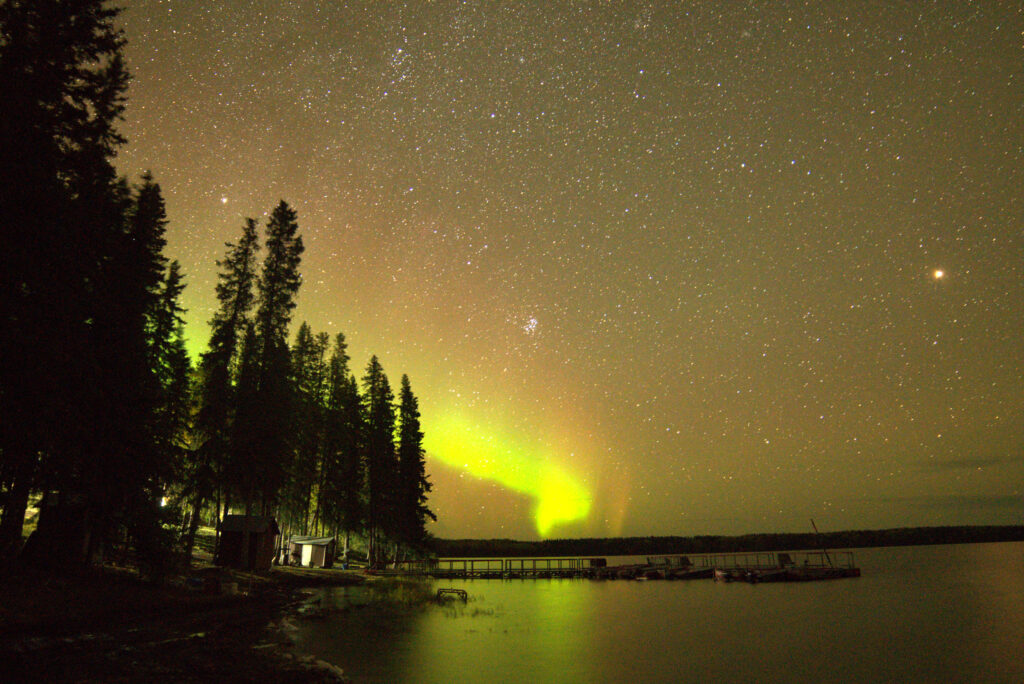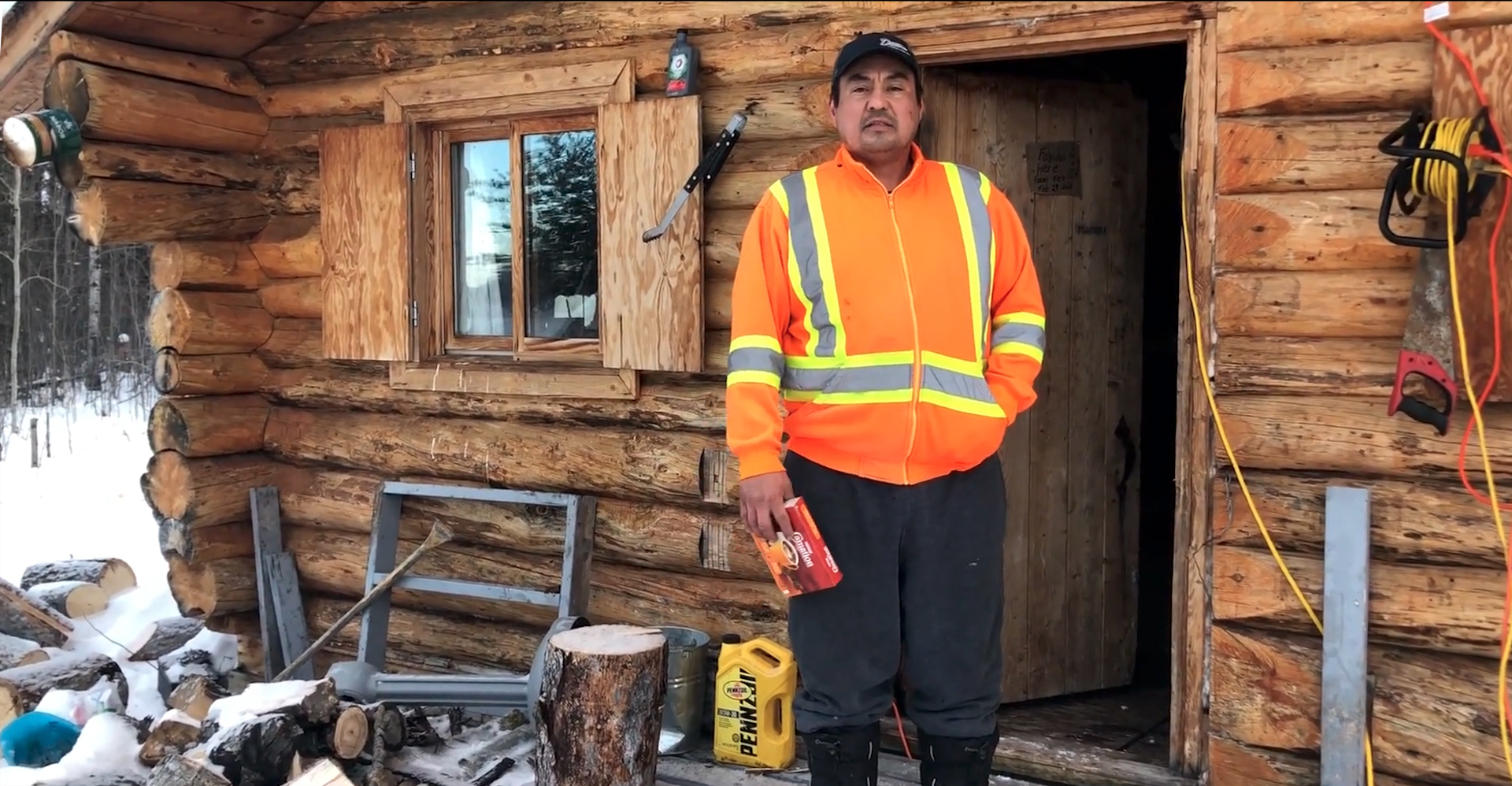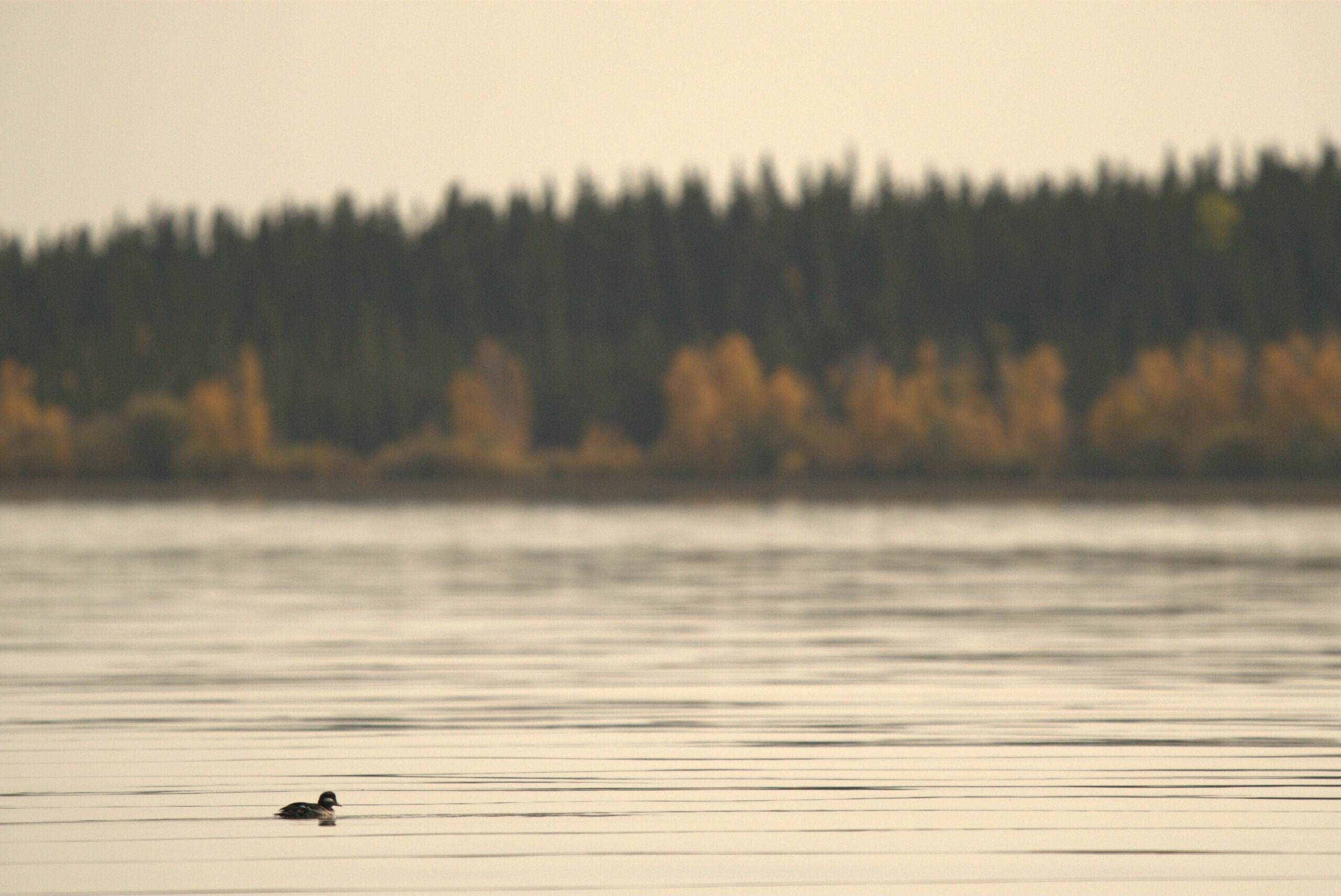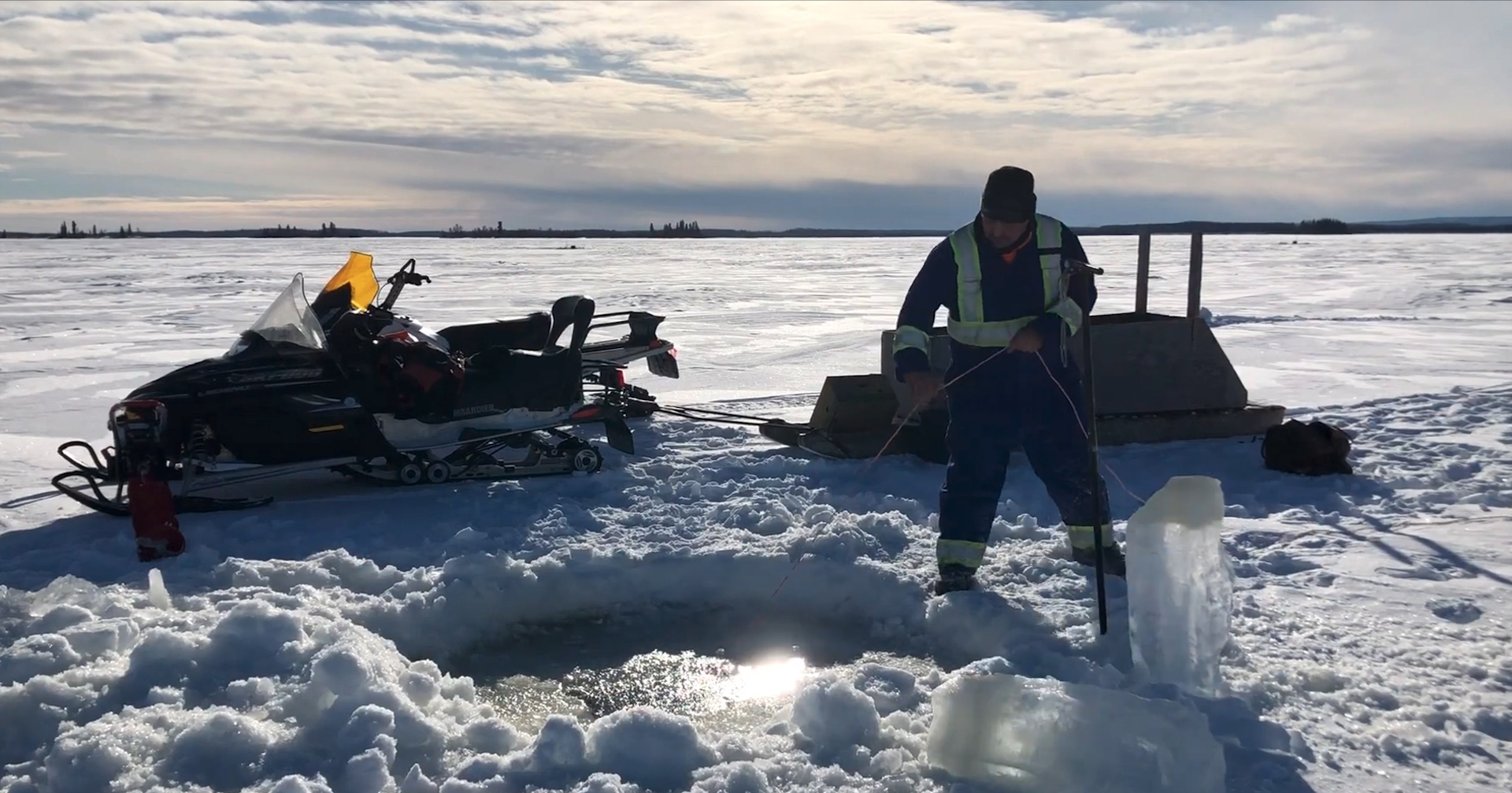
The Right Honourable Mary Simon aims to be an Arctic fox
Canada’s first-ever Indigenous governor general doesn’t play favourites among our majestic natural wonders, but she...
This story is part of Carbon Cache, The Narwhal’s ongoing series about nature-based climate solutions.
In the summer at Mbehcho (Bistcho) Lake in northern Alberta, 426 square kilometres of glassy water reflect huge skies surrounded by black spruce forests. Then there’s “horsefly season,” when moose are driven to rivers to escape the biting insects, and Elders tell stories of how Dene Tha’ used to set out on months-long canoe trips to hunt the moose.
In the winter, the lake freezes, allowing snowmobilers to crisscross its surface under pink twilight skies, setting up ice-fishing nets that yield some of the species found in its shallow waters: lake whitefish, arctic grayling, northern pike, burbot or walleye — some species reaching up to 18 kilograms.
“They’re good eating,” Michael Chambaud, a member of the Dene Tha’ First Nation, says on a phone call to talk about the lake. The burbot, he says with a chuckle, are “poor man’s lobster.”
Chambaud, who lives in nearby Meander River, Alta., heads out to Bistcho every winter with his family to set gill nets under the thick ice. The water is so pure there, he says, that he and his cousins and uncles take the blocks of ice they carve off the lake back to their small cabin where they use it to make tea and coffee.
The area has long been important to Dene Tha’, with recent archaeological studies revealing hundreds of artifacts pointing to thousands of years of history, as well as wagon trails and log house settlements overlooking the lake. To help conserve and restore parts of the region, the Dene Tha’ First Nation is proposing an Indigenous Protected and Conserved Area, which would be the first of its kind in Alberta.
“Historically the area was occupied by Dene people all over,” Chief James Ahnassay told The Narwhal in a Zoom call. “Our people have been there ever since the ice age.”
“There have been sites before the pyramids were even started,” Fred Didzena, the lands department director with the Dene Tha’ First Nation, added.
The lake is one of the largest in the province — a vast, shallow expanse of water at the centre of a larger region, covering thousands of hectares, within Dene Tha’ Traditional Territory. It’s rich in habitat for threatened caribou, with the Bistcho woodland caribou herd’s range overlapping much of the territory. Sandhill cranes, moose, wolverines and trumpeter swans make homes here.

Aside from some fly-in tourism, though, most Albertans will never visit, making the area a quiet reprieve for humans and wildlife alike. The lake is remote, approximately 90 kilometres outside Meander River, Alta., itself 8.5 hours northwest of Edmonton.
“It’s almost like the lake is suspended in time,” Matt Munson, a technician with the Dene Tha’ First Nation, told The Narwhal. “Time goes slower there. It just does.”
As the Dene Tha’ First Nation has put it, the region is significant for cultural and biological reasons, and can also be a “powerful tool in the fight against climate change.”
The area around Mbehcho Lake has some of the highest densities of soil organic carbon found in Alberta. Carbon is stored in the bogs and other wetlands that surround the lake.
“If you look at a square metre of peatland up in the Bistcho area, it is about five times more carbon than you would find in the same square metre in a tropical forest,” David Olefeldt, an associate professor of wetland and watershed sciences at the University of Alberta, told The Narwhal. Olefeldt has spent part of the summer in the Mbehcho region, setting up peatland research sites.
“Think of all the trees and foliage that you have in the deepest Amazon jungle and multiply that by five,” he said. “That’s the amount of carbon that you now have stored in these peatlands up north.”

When peatlands are disturbed by industrial development like seismic lines or oil and gas wells, he added, “this carbon dioxide that has been in storage for millennia, can enter the atmosphere very quickly.”
“Avoiding conversion or avoiding disturbance of the peatlands is one of the most important of all natural climate solutions,” he said
Nature-based climate solutions are based on the premise that because ecosystems like peatlands, boreal forests, grasslands and farmlands store enormous amounts of carbon, preventing their destruction can contribute to the fight against climate change. In a time of increasing evidence of our rapidly changing global climate, these carbon-rich landscapes are much more valuable intact.
A 2017 study published in the Proceedings of the National Academy of Sciences concluded nature-based climate solutions could provide more than one-third of the emissions reductions needed to stabilize global temperature increases below 2 C by 2030 under the Paris Accord. Canada is home to 25 per cent of the planet’s wetlands and boreal forests, meaning it has an outsized potential role to play. A 2021 study in Science Advances found that nature-based climate solutions could offset Canada’s greenhouse gas emissions by 11 per cent annually by 2030.
At Mbehcho, the potential to reduce carbon pollution by preventing its degradation is tremendous.
But that hasn’t stopped industrial activity in the region from disturbing the fragile ecosystem. In the boreal forest, Chief Ahnassay said, there has too often been an “onslaught” of human activity.

The proposed Indigenous Protected and Conserved Area could help the Dene Tha’ manage those competing uses.
The idea is to collaborate with other stakeholders to create a shared plan for the future, Munson told The Narwhal.
“This collaboration is a really great opportunity to have some good outcomes for communities and the environment and species in the environment that are in trouble,” he said. “That’s what it’s about.”
He’s hopeful a variety of stakeholders can come together to form a shared vision, including governments.
“Nations enter into treaties as allies. That’s underpinning all of this work,” he said. There are three criteria of an Indigenous Protected and Conserved Area, according to the Indigenous Circle of Experts formed to provide advice on Canada’s 2020 Biodiversity Goals and Targets. An Indigenous Protected and Conserved Area, the circle concluded, should be Indigenous-led, include a long-term commitment to conservation and elevate Indigenous rights and responsibilities. Munson hopes these principles can inform the future of Mbehcho.
“We are allies with Alberta; we are allies with Canada,” he said. “This is a way to celebrate that.”
When Kecia Kerr, the executive director of the Northern Alberta chapter of the Canadian Parks and Wilderness Society, visited Mbehcho Lake in the fall, she said, the tamaracks and cranberry bushes were changing colours, transforming the landscape into something of a brilliantly coloured canvas. Layers of peat and moss were underfoot. It is, she said, the “the perfect habitat for caribou.”
Boreal woodland caribou are, for many, a symbol of wilderness and the North, and have long been an important part of Indigenous ways of life.
But facing increasing economic encroachment on their habitat, populations have dwindled. Woodland caribou are listed as threatened both provincially and federally.
“The bush protects the animals,” Chambaud says of the habitat cut away to make way for oil and gas development. “If the bush was there, there’d be more animals.” He’s noticed a decline in the number of caribou he sees out on the land over the years.
“I used to go with my dad, we’d go trapping, and we’d see lots,” he says. “Now you don’t see hardly any.”

The majority of woodland caribou herds in Alberta have some form of protected lands within their range, be it national or provincial parks or other forms of conserved areas. The Bistcho herd has none.
The herd had been in decline, and was deemed not self-sustaining by the federal government in 2012, though there is some evidence it may have since “stabilized at reduced population levels,” according to the Alberta government.
The Dene Tha’ First Nation is already actively engaged in work to monitor the caribou herd by setting up remote cameras to monitor the population, in collaboration with the Canadian Parks and Wilderness Society’s Northern Alberta chapter. Woodland caribou are a species at risk, and are known to be sensitive to habitat changes from the encroachment of industrial activity.
According to the Alberta government’s draft caribou range plan, 60 per cent of the range is currently under forest management agreements for use by forestry companies.
On top of forestry activity, 91 per cent of the Bistcho Lake woodland caribou herd’s range overlaps with seismic lines for oil and gas exploration — amounting to over 60,000 kilometres of seismic lines criss-crossing the range. The range also includes over 2,000 kilometres of pipelines.
However, much of the impact is from legacy oil and gas activity, meaning it is no longer actively being used.
The Dene Tha’ First Nation believes an Indigenous Protected and Conserved Area could further help ensure restoration takes place.
“With the protected area in place, there would be an opportunity for regrowth in the area and that’s what we wish for,” Chief Anhassay told The Narwhal.
“The future generation is what we focus on when we work on protection of land.”
As is characteristic in much of the boreal, the area around Mbehcho Lake is rich in peat.
“There are peatlands and wetlands all around the lake,” Kerr told The Narwhal. “If you’re out there walking on the land, it’s like you’re walking on this giant sponge… it’s very squishy.”
But the impact of oil and gas development has left its mark on the fragile peat ecosystems.
“Cumulative effects of all of this development in our Traditional Territory threaten, not only our ability to continue to exercise Treaty rights, but also our cultural existence as Dene Tha’ people,” the Dene Tha’ First Nation wrote in a draft report making a case for an Indigenous Protected and Conserved Area.
It’s a concern that has been raised by Elders.
“On the whole, I think my family has been impacted by all the oil and gas and forestry that happened in our territory. We cannot go into areas that [we] once did and want to go. We cannot make a living as we once did from hunting, fishing and trapping. There are less animals in the areas around the communities where we live as they have been covered by roads, pipelines, and cut blocks. …The animals are shifting and moving to places further away from us,” an Elder said in a 2006 interview conducted by members of the Dene Tha’ First Nation for a report on traditional land uses prepared in response to proposed industrial development (this excerpt was provided to The Narwhal by Munson of the Dene Tha’ First Nation).




Not only does industrial activity hinder traditional Dene Tha’ ways of life, it can also disturb the vast carbon stores in the peatlands of the region, which are already threatened by climate change.
Peat moss, Olefeldt, the wetland scientist, explained, started developing 8,000 to 10,000 years ago, as the glaciers were retreating. Because the area was flat and the soil was fine, there was poor drainage, leading to extra wet ground on which new plant material grew — and died — each year.
“When you have cold and wet soil, it decomposes the plant material very, very slowly,” he said. Because plants contain carbon — taken out of the atmosphere in the form of carbon dioxide — that carbon ends up being stored in the soil, in the form of peat.
In many areas around Mbehcho, Olefledt said, there are between two and six metres of peat moss blanketing the earth.
And in the north, permafrost means much of that has long been frozen.
“Frozen carbon is going to decompose even slower,” he said, meaning it creates an even more secure carbon store.
But industrial activity and rapidly rising temperatures can change all of that.
Seismic lines and well pads, he said, means compacting the soil and removing trees, which in turn means less shade.
“When you are doing a seismic line or doing any activity on frozen peatland; when you disturb the soil on top of that frozen peat, you’re changing the properties of the soil and you’re often crossing complete permafrost degradation,” he said.
Permafrost degradation means the release of stored carbon, and is yet another reason an Indigenous Protected and Conserved Area around Mbehcho Lake could be not just locally important, but globally important too.
“[Indigenous Protected and Conserved Areas] are one of the most promising ways we could protect that area,” Olefeldt said.
“Maintaining the carbon-storing wetlands within the region will be critical to combating climate change,” the Dene Tha’ First Nation said in its case for an Indigenous Protected and Conserved Area.
Out on the land, climate change could impact traditional activities, thawing peat, but also altering when the lake freezes and for how long.
Those sorts of long-term trends affect people like Chambaud, who fishes on the lake every winter, setting out gill nets to bring in hauls of fish to feed his family and friends.

Setting up a gill net takes a couple of hours if you have help, Chambaud explains. A good catch will bring in about 80 fish these days, many of which he gives away to other members of the community.
Chambaud is hoping to inspire more young people — including his five young daughters and stepson — to learn the skills he learned as a child. He posts videos online on topics including skinning and trapping martens, picking juniper and rat root for medicinal use, checking beaver snares and setting gill nets on Bistcho Lake.
“My grandpa took my dad to Bistcho and my dad took me and now I take my kids to Bistcho and I’m hoping one day they’ll take their kids to Bistcho,” he says.
Back when his grandpa went out to Bistcho, the journey was much longer. What’s now a two-hour drive on a winter road was a full day’s walk, with a wagon and a team of dogs to pack their gear. His grandpa, Chambaud says, taught him the importance of taking only what you need from the land, with many of those lessons being taught around the shores of Bistcho Lake.
Thinking about the importance of the region to his community, Chambaud says he is supportive of the Dene Tha’ plan to move forward with conservation.
How exactly conservation moves ahead in the area is still in the planning stages.
Munson is certain the right place for the Dene Tha’ proposal is in the sub-regional planning process.
Subregional plans are, according to the Alberta government, a way of “supporting caribou recovery through careful land-use planning which recognizes and maintains working landscapes — ones supporting a variety of social, economic and traditional land-use.” The plans include guidance on future human activities — and the restoration of past ones — as well as plans for monitoring.
A task force for the Bistcho Lake sub-region included numerous stakeholders, including representatives of the oil and gas industry, Indigenous leadership, forestry, conservation groups, other land users and communities. One of the task force’s recommendations was to “explore the option of conservation areas (for example Indigenous Protected and Conserved Areas) in the Bistcho Lake area.”

A draft plan for the Bistcho Lake sub-region was released in March, but it did not include mention of an Indigenous Protected and Conserved Area. Since then, online public engagement has been completed, and Munson is optimistic the principles of Indigenous Protected and Conserved Areas are increasingly being recognized by the Alberta government. (Alberta Environment and Parks did not make anyone available for an interview.)
Whether an Indigenous Protected and Conserved Area is formally created remains up for discussion, but proponents are hopeful the principles of this kind of protection are upheld. They are, after all, central to Dene Tha’ ways of being.
“The [Indigenous Protected and Conserved Area] has always been who we are. We protected the lands,” Chief Anhassay said, mentioning practices like controlled natural burns on the landscape.
“All those practices have been there for thousands of years.”
Munson sees opportunities for various stakeholders to come together to create a shared vision for the region. “The idea is not to build a wall and keep everyone out of there,” he said.
And even if many Albertans never get the opportunity to visit the remote lake, he’s optimistic future engagement will mean more people will support the idea of “knowing those places exist in the world and people are actively doing things to keep the landscape in the best condition possible for the future.”
The Carbon Cache series is funded by Metcalf Foundation. As per The Narwhal’s editorial independence policy, the foundation has no editorial input into the articles.
Get the inside scoop on The Narwhal’s environment and climate reporting by signing up for our free newsletter. A $335 million funding commitment to fund...
Continue reading
Canada’s first-ever Indigenous governor general doesn’t play favourites among our majestic natural wonders, but she...

In Alberta, a massive open-pit coal mine near Jasper National Park is hoping to expand...

A trade war could help remake B.C.’s food system, but will family farmers be left...
